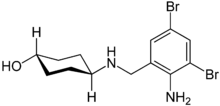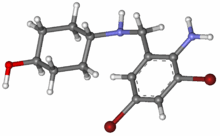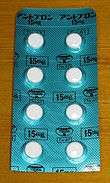Ambroxol
Ambroxol is a drug that breaks up phlegm, used in the treatment of respiratory diseases associated with viscid or excessive mucus. Recently, a hypothesis suggested that it may have a potential role in treatment of Paget's disease of bone, Parkinsonism, and other common diseases of aging-associated diseases involving dysfunction of autophagy.[1] Ambroxol is often administered as an active ingredient in cough syrup.
 | |
 | |
| Clinical data | |
|---|---|
| AHFS/Drugs.com | International Drug Names |
| ATC code | |
| Legal status | |
| Legal status |
|
| Identifiers | |
| |
| CAS Number | |
| PubChem CID | |
| ChemSpider | |
| UNII | |
| KEGG | |
| ChEMBL | |
| CompTox Dashboard (EPA) | |
| ECHA InfoCard | 100.038.621 |
| Chemical and physical data | |
| Formula | C13H18Br2N2O |
| Molar mass | 378.10 g·mol−1 |
| 3D model (JSmol) | |
| |
| |
| | |
It was patented in 1966 and came into medical use in 1979.[2]
Medical uses
Ambroxol is indicated as "secretolytic therapy in bronchopulmonary diseases associated with abnormal mucus secretion and impaired mucus transport. It promotes mucus clearance, facilitates expectoration and eases productive cough, allowing patients to breathe freely and deeply".[3]

There are many different formulations developed since the first marketing authorisation in 1978. Ambroxol is available as syrup, tablets, pastilles, dry powder sachets, inhalation solution, drops and ampules as well as effervescent tablets.
Ambroxol also provides pain relief in acute sore throat. Pain in sore throat is the hallmark of acute pharyngitis.[4] Sore throat is usually caused by a viral infection. The infection is self limited and the patient recovers normally after a few days. What is most bothering for the patient is the continuous pain in the throat maximized when the patient is swallowing. The main goal of treatment is thus to reduce pain. The main property of ambroxol for treating sore throat is the local anaesthetic effect, described first in the late 1970s,[5][6] but explained and confirmed in more recent work.
Side effects
Field tests to date have not uncovered specific contraindications of ambroxol; however, caution is suggested for patients with gastric ulceration, and usage during the first trimester of pregnancy is not recommended.[7]
Mechanism of action
The substance acts on mucus membranes, restoring the physiological clearance mechanisms of the respiratory tract (which play an important role in the body’s natural defence mechanisms) through several mechanisms, including breaking up phlegm, stimulating mucus production, and stimulating synthesis and release of surfactant by type II pneumocytes.[8][9] Surfactant acts as an anti-glue factor by reducing the adhesion of mucus to the bronchial wall, in improving its transport and in providing protection against infection and irritating agents.[10][11]
Ambroxol is a potent inhibitor of the neuronal Na+ channels.[12] This property led to the development of a lozenge containing 20 mg of ambroxol. Many state-of-the-art clinical studies[4] have demonstrated the efficacy of ambroxol in relieving pain in acute sore throat, with a rapid onset of action, with its effect lasting at least three hours. Ambroxol is also anti-inflammatory, reducing redness in a sore throat.
Ambroxol has recently been shown to increase activity of the lysosomal enzyme glucocerebrosidase. Because of this it may be a useful therapeutic agent for both Gaucher disease and Parkinson's disease.[13]
It was also recently shown that ambroxol triggers exocytosis of lysosomes by releasing calcium from acidic cellular calcium stores. This occurs by diffusion of ambroxol into lysosomes and lysosomal pH neutralization.[9] This mechanism is most likely responsible for the mucolytic effects of the drug, but may also explain the reported activity in Gaucher and Parkinson's disease.
Both ambroxol and its parent drug bromhexine have been shown to induce autophagy in several cell types, and ambroxol was shown to potentiate rifampicin therapy in a model of tuberculosis through host directed effects.[14][15] Ambroxol also enhances lung levels of a wide range of antibiotics.[16] Ambroxol also had activity against SARS CoV2 in Vero E6 cells, although the mechanism of action is as yet unknownn[17]
Brand names
It is the active ingredient of Muciclar (Italy), Mucosolvan, Mucobrox (Spain), Mucol, Lasolvan, Mucoangin, Surbronc, Brontex (Lithuanian), Ambolar, and Lysopain.
References
- Dockrill, Peter. "A Common Cough Syrup Drug Just Passed Another Trial as Parkinson's Treatment". ScienceAlert. Retrieved 2020-02-17.
- Fischer, Jnos; Ganellin, C. Robin (2006). Analogue-based Drug Discovery. John Wiley & Sons. p. 544. ISBN 9783527607495.
- Malerba M, Ragnoli B (August 2008), "Ambroxol in the 21st century: pharmacological and clinical update", Expert Opin Drug Metab Toxicol, 4 (8): 1119–29, doi:10.1517/17425255.4.8.1119, PMID 18680446
- de Mey C, et al. (2008), "Efficacy and safety of ambroxol lozenges in the treatment of acute uncomplicated sore throat", Arzneimittelforschung, 58 (11): 557–68, doi:10.1055/s-0031-1296557, PMID 19137906
- Püschmann S, Engelhorn R (1978). "[Pharmacological study on the bromhexine metabolite ambroxol (author's transl)]". Arzneimittel-Forschung. 28 (5a): 889–98. PMID 581987.
- Klier KF, Papendick U (December 1977). "[The local anesthetic effect of NA872-containing eyedrops]". Medizinische Monatsschrift. 31 (12): 575–8. PMID 593223.
- "Ambroxol". Drugs.com. Retrieved 21 January 2014.
- Seifart C, Clostermann U, Seifart U, Müller B, Vogelmeier C, von Wichert P, Fehrenbach H (February 2005). "Cell-specific modulation of surfactant proteins by ambroxol treatment". Toxicology and Applied Pharmacology. 203 (1): 27–35. doi:10.1016/j.taap.2004.07.015. PMID 15694461.
- Fois G, Hobi N, Felder E, Ziegler A, Miklavc P, Walther P, Radermacher P, Haller T, Dietl P (December 2015). "A new role for an old drug: Ambroxol triggers lysosomal exocytosis via pH-dependent Ca²⁺ release from acidic Ca²⁺ stores". Cell Calcium. 58 (6): 628–37. doi:10.1016/j.ceca.2015.10.002. PMID 26560688.
- Sanderson RJ, Paul GW, Vatter AE, Filley GF (September 1976). "Morphological and physical basis for lung surfactant action". Respiration Physiology. 27 (3): 379–92. doi:10.1016/0034-5687(76)90066-9. PMID 989610.
- Kido H, Okumura Y, Yamada H, Mizuno D, Higashi Y, Yano M (November 2004). "Secretory leukoprotease inhibitor and pulmonary surfactant serve as principal defenses against influenza A virus infection in the airway and chemical agents up-regulating their levels may have therapeutic potential". Biological Chemistry. 385 (11): 1029–34. doi:10.1515/bc.2004.133. PMID 15576322.
- Weiser T (March 2006). "Comparison of the effects of four Na+ channel analgesics on TTX-resistant Na+ currents in rat sensory neurons and recombinant Nav1.2 channels". Neuroscience Letters. 395 (3): 179–84. doi:10.1016/j.neulet.2005.10.058. PMID 16293367.
- McNeill A, Magalhaes J, Shen C, Chau KY, Hughes D, Mehta A, Foltynie T, Cooper JM, Abramov AY, Gegg M, Schapira AH (May 2014). "Ambroxol improves lysosomal biochemistry in glucocerebrosidase mutation-linked Parkinson disease cells". Brain. 137 (Pt 5): 1481–95. doi:10.1093/brain/awu020. PMC 3999713. PMID 24574503.
- Choi SW, Gu Y, Peters RS, Salgame P, Ellner JJ, Timmins GS, Deretic V (July 2018). "Ambroxol induces autophagy and potentiates Rifampin antimycobacterial activity". Antimicrobial Agents and Chemotherapy. 62 (9): AAC.01019–18. doi:10.1128/AAC.01019-18. PMC 6125555. PMID 30012752.
- Chauhan S, Ahmed Z, Bradfute SB, Arko-Mensah J, Mandell MA, Won Choi S, et al. (October 2015). "Pharmaceutical screen identifies novel target processes for activation of autophagy with a broad translational potential". Nature Communications. 6: 8620. doi:10.1038/ncomms9620. PMC 4624223. PMID 26503418.
- Deretic, Vojo; Timmins, Graham S. (2019). "Enhancement of lung levels of antibiotics by ambroxol and bromhexine". Expert Opinion on Drug Metabolism & Toxicology. 15 (3): 213–218. doi:10.1080/17425255.2019.1578748. PMC 6947664. PMID 30721101.
- Ambroxol and ciprofloxacin have activity against SARS CoV2 in Vero E6 cells. Bradfute et al BioRxiv https://www.biorxiv.org/content/10.1101/2020.08.11.245100v1 https://doi.org/10.1101/2020.08.11.245100
| Wikimedia Commons has media related to Ambroxol. |